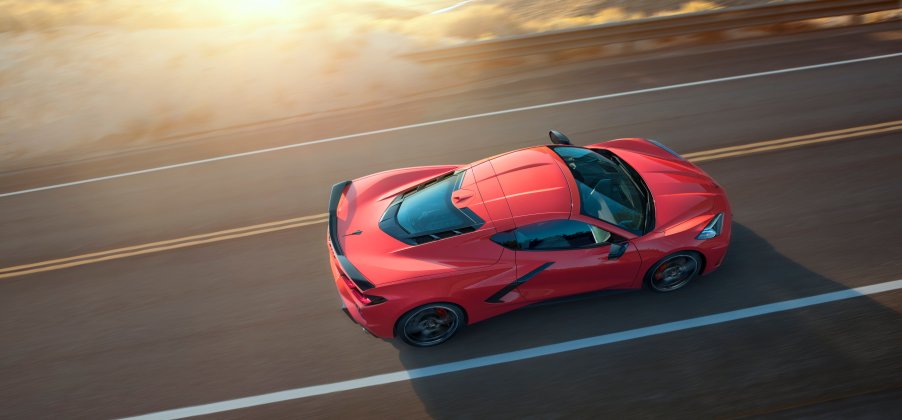
2020 Chevrolet Corvette Z06 May Get a Twin-Turbo V8
It looks like at least some of the wilder speculation about what the future holds for the C8 Corvette is actually coming true. Both the C8.R race car and more importantly for you the C8 Z06 will be powered by a twin-turbo dual-overhead-cam flat-plane-crank V8 according to a source that spoke to MotorTrend. From sources who have both seen and heard the C8.R testing at Sebring, the exhaust note is unique, and that’s due to the flat-plane-crank. What’s that?
Flat-Plane-Crank
A flat-plane-crank is also called a 180-degree crank. Harley-Davidson motorcycles have flat-plane-cranks–that’s what gives them that unique burble-burble sound at a stoplight. Flat-plane-cranks have a 180-degree firing order, so the crankshaft throws are completely offset, as opposed to a cross-plane-crank that rotates the crankshaft throws around the axis of the crank at 12-, 3-, 6-, and 9-o’clock positions.
Vibration Woes
But cross-plane-cranks were developed for a reason–vibration. Or rather lack of vibration. Just like that Harley at the light, flat-plane-crank engines vibrate all over the place. Since the firing order on a cross-plane is spaced out, it helps to balance the engine reducing vibration. As speeds increase in a flat-plane car the vibrations only get worse. In a race car, it doesn’t matter–just like in a Harley. But in a street car, it’s more disconcerting.
There need to be some compromises if you want to reduce vibration. Lightweight pistons and shorter crankshaft strokes help because there is less reciprocating mass with lighter pistons, and short strokes create less piston distance traveled, so there is less torque. Less torque means less throw of the pistons.

Flat-plane engines can increase and then decrease revs quicker and have less power loss from having to “throw” the piston rods, so there is less rotational inertia. Exhaust scavenging is improved which means the combusted mixture is released quicker. You know that the quicker (and larger volume) the air is in, and then out of an engine the more efficient it is. Scavenging uses pressure waves from the combustion to help push the combusted air out of the cylinder.
We also love the sound of a flat-plane engine. They create a low-pitch sound. Less bumble bee-like and more of a growl. An angry growl.
Won’t Be An LS
But this engine is not a variation of an LS because it won’t have pushrods like an LS. It has a lot more in common with Cadillac’s Blackwing engine and its overhead cam layout. GM has been adamant the Blackwing will stay exclusively with Cadillac, but that doesn’t mean Chevy can’t wade into the Blackwing’s development to create their own version.

Rumors speculate that while the heads and crank are definitely unique, the block is probably a variant of the Blackwing. But the Blackwing is an under- square engine with a long stroke, which is good for torque but bad for racing. You can’t move the crankshaft center up into the engine without disrupting all of the advantages for using an existing block. But you can bore it to get more in the ballpark of the stroke dimensions. An under-square engine has a dimensionally longer stroke than the diameter of its bore. Obviously, over-square engines reduce piston speeds and ease vibrations.
Won’t Be A Ford V8 Voodoo
Ford’s V8 Voodoo engine used in the GT is a 5.2-liter flat-plane-crank configuration, and they are eating themselves alive. For comparison Ferrari runs a 3.9-liter engine. Expect Chevy to balance the displacement it finds for the Blackwing with reliability and vibration concerns. It won’t get too close to Ford’s 5.2-liter size because of the issues Ford has experienced.
Chevy is rumored to be planning a fall reveal for the C.8R, but don’t forget that the C8 Z06 will have a lot in common with the C.8R’s nasty engine. Motorbiscuit will have all of the info once Chevy releases it!



